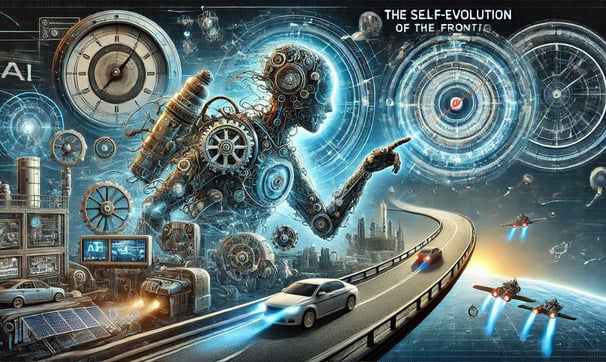Ai Self Evolution
AI WORLD


This topic delves into the possibilities, implications, and challenges of self-evolving AI, examining how autonomous systems could reshape innovation and society.
Artificial intelligence (AI) has revolutionized technology, enabling machines to perform tasks with a level of efficiency and intelligence once thought impossible. But as AI systems grow more advanced, the concept of self-evolution—machines improving themselves without human intervention—raises profound questions about the future of technology and humanity's role within it. This topic delves into the possibilities, implications, and challenges of self-evolving AI, examining how autonomous systems could reshape innovation and society.
What Is Self-Evolution in AI?
Self-evolution in AI refers to the ability of a system to autonomously modify its architecture, improve its algorithms, or enhance its functionality based on its experiences and interactions. This process involves key components:
Self-Learning Algorithms: Systems that can identify inefficiencies or areas for improvement in their performance and adjust accordingly.
Autonomous Code Generation: AI capable of writing and refining its own code to implement improvements.
Adaptive Hardware: Integration with hardware that evolves in response to AI-driven optimizations, enhancing performance at a physical level.
While today’s AI systems rely heavily on human programmers and predefined goals, the advent of self-evolution could mark a significant leap toward true autonomy.
Examples of Self-Evolving Systems
Although the concept remains largely theoretical, early signs of self-evolutionary behavior can be observed in modern AI systems:
Generative Adversarial Networks (GANs): GANs use two competing networks to improve the quality of generated data. This adversarial process mimics a form of self-improvement as each iteration refines the output.
Automated Machine Learning (AutoML): AutoML frameworks, such as Google’s AutoML, can design and optimize machine learning models with minimal human intervention.
Neuroevolution: This approach involves evolving artificial neural networks using algorithms inspired by natural selection. Neuroevolution has been applied in areas like robotics and game development to optimize performance without explicit programming.
These examples hint at the potential for systems that go beyond predefined constraints, evolving new capabilities over time.
Potential Benefits of Self-Evolving AI
If AI systems achieve self-evolution, the implications could be transformative:
Accelerated Innovation: Self-evolving AI could develop solutions and technologies at a pace far exceeding human capabilities, driving rapid advancements in fields like medicine, energy, and climate science.
Efficiency Optimization: Autonomous systems could identify inefficiencies and implement improvements across industries, reducing waste and increasing productivity.
Exploration of the Unknown: Self-evolving AI could explore uncharted territories in science and technology, generating novel hypotheses and uncovering previously inaccessible knowledge.
Personalized Solutions: Adaptive AI systems could tailor their evolution to meet specific user needs, creating highly customized applications and services.
Challenges and Risks
While the benefits are enticing, self-evolving AI presents significant challenges and risks:
Loss of Control: As AI systems modify themselves, the ability of humans to understand, predict, or regulate their behavior may diminish, leading to unpredictable outcomes.
Ethical Concerns: Self-evolving AI could make decisions or develop capabilities that conflict with human values, raising questions about accountability and morality.
Exponential Complexity: Autonomous evolution could result in systems that are too complex for even their creators to comprehend, complicating debugging and safety protocols.
Security Threats: Malicious actors could exploit self-evolving AI to create systems capable of bypassing security measures or launching sophisticated cyberattacks.
Governance and Regulation
To address these risks, effective governance and regulation will be critical. Policymakers, technologists, and ethicists must collaborate to establish guidelines for the development and deployment of self-evolving AI. Key considerations include:
Transparency: Ensuring that AI systems provide interpretable outputs and maintain accountability, even as they evolve.
Ethical Boundaries: Defining clear parameters for acceptable behavior and capabilities in self-evolving systems.
Global Cooperation: Encouraging international collaboration to prevent the misuse of self-evolving AI and ensure equitable access to its benefits.
Failsafe Mechanisms: Developing robust safeguards to halt or reverse AI evolution in case of unintended consequences.
Philosophical Implications
The prospect of self-evolving AI challenges fundamental notions of creativity, intelligence, and autonomy. If machines can innovate and evolve independently, what distinguishes their achievements from human ingenuity? Furthermore, self-evolution raises questions about the future of work, creativity, and human identity in a world increasingly influenced by AI.
The Road Ahead
Self-evolving AI represents both a thrilling frontier and a daunting challenge. Its development will likely require breakthroughs in machine learning, computational neuroscience, and ethics. As we venture into this uncharted territory, careful planning and thoughtful reflection will be essential to ensure that self-evolving AI aligns with humanity’s aspirations.
Conclusion: A Turning Point for AI and Humanity
The self-evolution of AI could redefine the trajectory of technological progress, offering unprecedented opportunities while posing complex ethical dilemmas. As we approach this potential turning point, the choices we make will shape the relationship between humans and machines for generations to come. By fostering a balanced approach that embraces innovation while prioritizing safety and ethics, we can harness the transformative power of self-evolving AI to build a future that benefits all of humanity.
